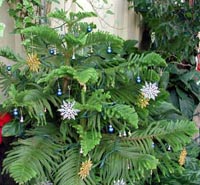Resource Library
Plant of the Week: Pine, Norfolk Island
The University of Arkansas System Division of Agriculture does not promote, support or recommend plants featured in "Plant of the Week." Please consult your local Extension office for plants suitable for your region.
Plant of the Week
Norfolk Island Pine
Latin: Araucaria heterophylla

Christmas approaches, and stores are bedecked in all their seasonal splendor and crammed full of merchandise. Plants aren’t left out of this seasonal onslaught.
A plant that makes a return to prime shelf space every December is the Norfolk Island pine, the perfect living Christmas tree for apartment dwellers. From outward appearances there is little to indicate that the small tabletop specimens adorned with red bows and miniature ornaments is in reality a forest giant of the South Pacific.
Norfolk Island Pine (Araucaria heterophylla) is one of the relatively few conifers of the southern hemisphere. It's reportedly capable of attaining 200 feet in height, but in most tropical areas, seldom exceeds half that. As a landscape tree, it grows ramrod straight with whorled branches arising at right angles to the main trunk. These swoop down in a graceful sweep creating a picturesque form for older trees.
The flattened, incurved, awl-shaped needles are light green, quarter-inch long affairs that sheath the young branches. Because the trees of commerce are all grown from seed, we see only juvenile foliage. Like more common conifers such as pines and spruce, the needles are not immortal. As the needles attain a few years' age they begin to fall off, leaving bare, inner branches.
The Norfolk Island pine is native to a small speck of land by the same name in the middle of the South Pacific, about 900 miles due east of the eastern bulge of Australia. The tiny island consists of only 13 square miles. In its splendid isolation from outside influences, the Norfolk Island pines evolved into a unique race of plants unlike the other dozen Araucarias scattered across the South Pacific.
Norfolk Island was discovered in 1774 during the second voyage of exploration by Captain James Cook on behalf of the Royal Navy. On this voyage as captain of the Resolution, Cook was at sea for just over three years and logged more than 70,000 miles. At one time the crew went 117 days without seeing land - all without the benefit of GPS or satellite phones. Cook, who discovered New Zealand on his first voyage and Antarctica on his second, was to be killed on his third voyage by natives of the big island of Hawaii in 1779.
Growing Norfolk Island pines is relatively easy so long as they are given a bright location and uniformly moist conditions. But it must always be remembered that you're trying to keep a tropical giant small enough to fit in your living room. At least for a time, plant size can be maintained by suppressing root growth. Just as the Japanese keep trees small using bonsai techniques, smaller pots keep the size of Norfolk Island pines down.
Plants grown in 6-inch pots will usually get about 2 feet tall and then stop growing. If transplanted to an 8-inch pot they will grow another foot and stop again. You can see where this is headed. By the time the plant is in a 24-inch pot, the tree is 12 feet tall, and you’ve got a problem. It’s too tall for the house.
You can stop transplanting to a larger pot anywhere in the progression, but after a couple years, the tree begins to behave like a loblolly pine grown in close formation. It drops its lower limbs and looks like a beach umbrella with only foliage at the top.
At this time, it's time to test for winter hardiness. The winter hardiness test is simple. Leave your overgrown Norfolk Island pine on the patio and see if it'll survive an Arkansas winter. Of course it won’t, but you can appease any feelings of guilt by saying you were doing it in the name of science.
By: Gerald Klingaman, retired
Extension Horticulturist - Ornamentals
Extension News - December 5, 2003
The University of Arkansas System Division of Agriculture does not maintain lists of retail outlets where these plants can be purchased. Please check your local nursery or other retail outlets to ask about the availability of these plants for your growing area.